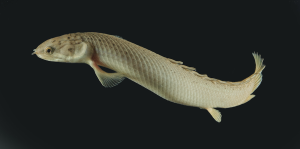
Bichir (Polypterus senegalus) live in freshwater lakes and rivers in East Africa, but can walk across land to reach new habitat. A new study shows just how much the fish can change if forced to live a terrestrial life. (Photo Credit: Antoine Morin)
A new study shows just how much a fish can change when raised in a land environment, and sheds light on the role such changes could have played in the evolution of land animals.
Bichir (Polypterus senegalus) have both gills and lungs and, although they prefer water, can walk across land to reach new habitat if their old one dries up. Researchers set up an experiment where bichir lived for 8 months on land and saw that they walked with a more effective gait; they also had changes in their pectoral fin anatomy that resemble some key evolutionary changes that are seen in the fossil record.
This plasticity – the ability of an organism to change its behaviour, shape or physiology in response to its environment – may also have been present in ancient fishes and could have facilitated their successful transition onto land.
Original research paper published in the journal Nature on August 27, 2014.
Names and affiliations of selected authors

